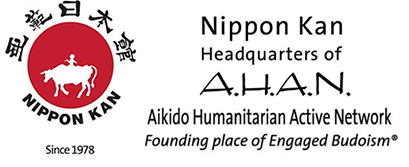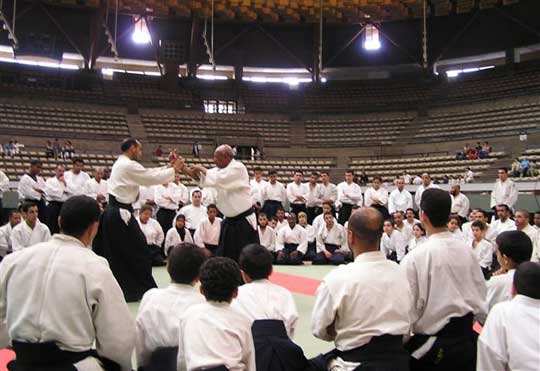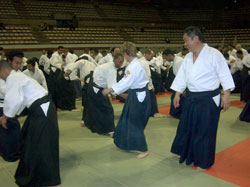Written by
Gaku Homma
Nippon Kan Kancho
March 25, 2005
About twenty years ago, I remember a visiting student who came one day to Nippon Kan to practice. This student practiced at about a sankyu or brown belt, hakama level of experience. What I remember most about this student was that by the way he practiced I could easily tell who his teacher was; and who his teacher’s teacher was before him.
It used to be that a student’s practice history could be determined even by observing the way a student did a tenkan exercise, sat in seiza or performed funekoki undo (rowing exercise). The way a student wore his or her hakama (how long it was or how it was tied) or how they walked could tell you a lot about the roots of their practice.
During the years that the Founder Morihei Ueshiba was at Hombu dojo in Tokyo, all of the shihan of that era had their own very distinct style of movement and teaching methods. Each shihan of that time developed their own following of students that were drawn to their particular interpretation of movement in the art of Aikido.
Past Aikikai shihan from this era that have since passed away had their own gift of movement. The late Osawa Shihan’s beautiful and precise technique was delivered with warmth and kindness. The late Yamaguchi Shihan is remembered for his soft but powerful whip-like movements, and the popular Hombu Sunday Practice instructor, the late Saito Shihan was known for his power and solidity. The late Nishio Sensei was known for his expertise not only in Aikido but in other arts as well.
Shihan of that era still living continue to pass down their own particular style and methodology. Ki Aikido’s Founder, Koichi Tohei Shihan has a very methodical approach towards Aikido. Tada Shihan is famous for his “one thousand practices of each technique”, and Kobayashi Shihan will always be known for his expertise in suwarewaza technique. All of these Shihan began their practice under the Founder, and carry his movement in their technique, yet each developed a very unique style and expertise unto their own.
During the late 60’s and early 70’s, in the pioneer era of Aikido development in the United States, Koichi Tohei Shihan was Chief Instructor of Aikikai. All of the Japanese shihan who first came to the United States as pioneers came under his supervision, yet they all had different backgrounds. They all carried with them the styles they had developed in their own training with their own teachers.
In later years after a period of solidification of Aikido organizations in the United States, Saotome Sensei, a student of Yamaguchi Shihan arrived in the United States. His movements distinctly reflect the teachings of Yamaguchi Shihan and are quite different than the movements of the Founder. This movement style is easy to recognize in students of Saotome Sensei, as are the movement of students of Yoshinkan Aikido and Tomiki Aikido.
Today when visiting students come to practice at Nippon Kan or I meet other Aikidoka at seminars, it is more difficult to ascertain through their movements who their instructors are. It seems like the color and style of the pioneer generation of instructors has been “watered down” through descendant generations. It may be a sign of our times, with Aikido seminars being held somewhere every weekend, that students who practice under a number of different instructors are becoming “technical Aikido hybrids”. Today, especially in the United States and Europe, students are able to pick and choose between instructors, and there is a tendency to “shop” for and learn only select techniques from select instructors. This results in a student being able to learn a repertoire of “cool” techniques, but it does not work toward learning a solid foundation through a consistent teaching method. Learning like this may give one a flashy demo-style, but it is not learning on a deeper level and the technical foundation given to us by our predecessors is in danger of becoming lost.
In today’s Aikido world, to find an instructor that keeps to traditional teaching and follows the deeper principals of the art is very valuable. The experience of these instructors is based on a traditional heritage that is disappearing. Already in our history, teachings that have disappeared even at their source remain in outlying pockets of descendants.
For example, Brazilian Gracie Jujitsu has its origin in Japanese Jujitsu. Kodokan Judo’s Kose or Mitsuo Maeda who also was well versed in the Japanese martial art of Jujitsu traveled to Brazil in 1914 where he instructed the Gracie family in the art. For almost a century this art has become Brazilian Gracie Jujitsu and the source of this art in Japan is no longer practiced. Today Gracie Jujitsu and Kodokan Judo have grown into two completely separate arts. The fact that this original Japanese Jujitsu has survived in Brazil, close to its original form is very valuable.
I have lived in Denver now for over thirty years. In the first years living in Denver I had the opportunity to meet many of the first generation of Japanese immigrants (issei) who came to Denver many decades ago. I found it fascinating that when I visited with this generation of immigrants that old Japanese customs, language and even cooking methods had been preserved in their lives that had all but disappeared in modern Japan. I used to sit for hours and listen to this special generation of senior citizen recall the historical world events that they had experienced first hand. I still have the notebooks where I recorded details from these conversations, and the information in them is quite valuable from a historical perspective. In my travels I have discovered practices alive and well in other countries that have been relegated to the history books in Japan.
This last March I visited Morocco and had the honor to meet Morocco Shudo Kan Aikido Alaoui M’barek Sensei. Alaoui Sensei I discovered was a unique and rare individual and an instructor that carried with him Aikido tradition that had its roots very close to the source.
Currently there are about 135 Aikido dojos and about 5000 practicing Aikidoka in Morocco. Close to 3000 of those practicing Aikidoka belong to the Morocco Aikido Federation. Alaoui Sensei has been practicing Aikido for over fifty years and until recently was the Director of the Morocco Aikikai Federation.
Fifty years ago, when Alaoui Sensei began his practice of Aikido, Morocco was a colony of France. In 1956, Morocco gained their independence from France, and in 1965 Alaoui Sensei returned from practicing Aikido in France to begin teaching in Morocco. Not only has Alaoui Sensei taught thousands of students, he has taught generations of students. Today he is still a vital and active instructor in Morocco and other countries of Northern Africa.
In 1952, the late Tadashi Abe Shihan, an Iwama uchideshi under the Founder, came to France as a pioneer instructor. His successor was Aikikai Tamura Shihan who remains as a leader in the French Aikido community. An officer of the Morocco Aikido Federation told me “Quite frankly, Aikido in Morocco has remained under French direction since the time Morocco was a colony of France. Since Tamura Shihan is now over seventy years old, it might be better for the Morocco Aikido Federation to develop its own direct relationship with Aikikai rather than continuing to maintain our affiliation through France. This is something we would like to consider, but it is a difficult situation politically and we do honor our relationship with Tamura Shihan. It is a difficult step to take”.
What I was hearing did not surprise me. I have heard this discussion before in other Aikido communities. As I sat sipping the mint tea that I had been so graciously served, I contemplated the current reality that in many places a change of generations was taking place between the original Japanese shihan who were pioneers and succeeding native instructors. Many new native instructors and “colony” organizations are now wishing for their own independence. There was nothing to say; everyone must find the way that is best for them.
What was important for the moment was how impressed I was with Alaoui Sensei’s Aikido technique and teaching method. At seventy years young, Alaoui Sensei’s technique and the skill of his assistants were beautiful to watch. His movements were spontaneous, not choreographed and his ukes responded to real technique, not a flick of the hand. Even though I could not understand his words, I could see how eloquently he captured his student’s hearts as he explained his techniques. His message and his touch were crystal clear.
Alaoui Sensei’s techniques, for example the way he performed kotegaeshi was very clear and correct. It had been a long time since I have had the opportunity to watch an instructor whose techniques had reason behind them. Today usually kotegaeshi is performed with the nage twisting their uke’s entire arm outward using a circular movement like one is turning a large crank. The reason for performing this technique in this manner is to catapult uke into a high flying break roll used a lot in demonstrations. This execution style has become “the norm”, and is taught as “correct” technique.
Executing the technique in this fashion leaves nage vulnerable to various counter- attacks from uke including a round kick, punch etc. It is not based in reality; it is more of a show technique against a partner that will not counter-attack. If you performed the technique like this on a first year karate student, he or she could easily flatten you with a high round side kick to the head or ribs. When this interpretation of kotegaeshi began I am not sure, but I do know that it started with the University Aikido Clubs that perform at the All Nippon University Club demonstrations in Japan. These demonstrations have become a contest in acrobatics, each club trying to “out fly” one another. Most likely, students from these university clubs that went on to become instructors took these techniques with them, teaching their own students this interpretation as truth not acrobatics.
Direct students of the Founder in Iwama did not teach techniques the way that they have been interpreted in city dojos (machi dojos). Photographs and films of the Founder show that these techniques were done differently. Correctly, kotegaeshi for example, is done by “rolling” ukes hand, fingers toward his inner wrist or pulse area, not outward in a large circle. By performing this technique in this manner, uke is rendered unable to counter with a kick or punch; having instead to roll backwards away from the pain. Traditionally this is the way this technique was performed, and there still are dojos that practice in this fashion, it depends on the roots of practice of the instructor.
In the beginning of the evolution of Aikido as an art around the world, techniques were disseminated first by Japanese pioneer shihan who went to countries around the globe to teach the art. As time has passed, many of this generation have passed on, and the next generations have taken on the roles of instructors. If these instructors have had limited exposure to other styles of technique, their instruction has remained truer to their source. Instructors with exposure to other styles and to other instructors as in the United States, their students’ techniques become endangered of becoming Aikido tossed salad.
The point of this article is the importance of preserving the teaching of our traditional heritage. This tradition began with the Founder, and in his day, international teaching standards, rules, and the elaborately complex system of organizations prevalent in our world today did not yet exist. Today these teachings have been passed from that generation to the next, and what this next generation carries is important to preserve. I respect those who have faithfully passed on the teaching they received without falling to the whims of technical fashion, and without making tossed salad out of what they have been taught.
The Founder Morihei Ueshiba spent a lifetime developing his art of Aikido and over his lifetime he had many direct students. It is important in understanding our traditional heritage to understand that during his lifetime, his technical and philosophical understanding of the art of Aikido changed and developed. Students from different periods in his life learned differently, and some of those students went on to develop their own organizations based on what they had learned. This is how Yoshinkan Aikido, Tomiki ryu, and Ki Aikido were born, and these styles resemble most closely the Aikido that the Founder taught in certain periods of his life.
Some question the validity of our system of Aikido heritage passed on directly through bloodlines. Aikido does not lie in blood; it lies in spirit and technique. Even an organization as steeped in tradition as the Catholic Church and the Vatican chooses a Pope by consensus of elders. Utmost in importance is our responsibility to the next generations to teach our traditional heritage in technique and philosophy as correctly and clearly as we can.
This trip to Morocco was realized through the efforts of a student from Morocco I met in Turkey last year. She works with the World Peace Women’s Association, and is very interested in the promotion of women through Aikido in Morocco.
At the resulting seminar in Casa Blanca, March 19-20, 2005 150 Aikidoka gathered, and five of them were women. I was honored to be able to teach in tandem with Alaoui M’barek Sensei of Morocco and JICA, (the Japan International Cooperation Agency) Instructor Takeo Nishiyama Sensei. Nishiyama Sensei who came to Morocco for two years as part of a JICA outreach program will be returning to Japan in May.
- Alaoui M’barek Sensei teaching in Casa Blanca.
- Homma Kancho
The seminar had a wonderful tone to it, and I was most impressed by the level of expertise of the attending Moroccan students. Everyone was very kind to us and served as wonderful hosts. I was able to attend Alaoui Sensei’s practice which was a delightful experience. Many sincere thanks to all who made the experience an unforgettable one.
Accompanying me on this journey to Morocco was Emily Busch, AHAN President, and Nippon Kan Vice President and Kazumi Yoshimura, a member of Nippon Kan Staff.




